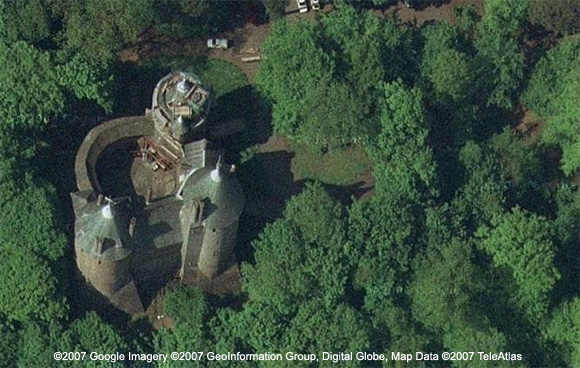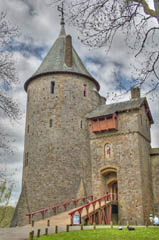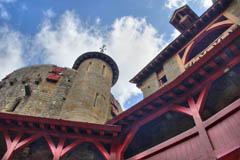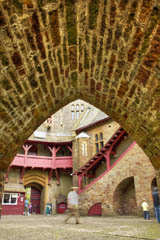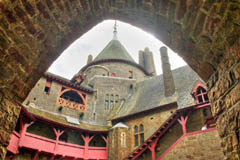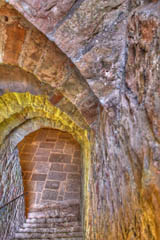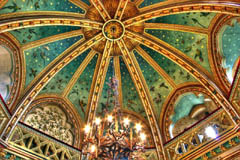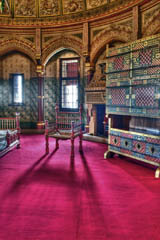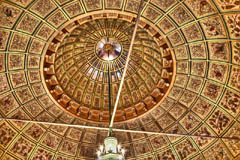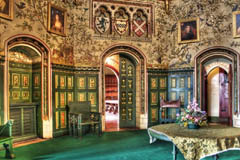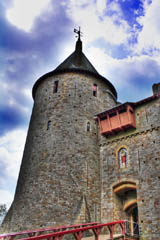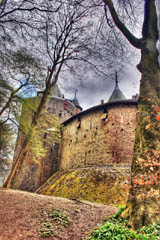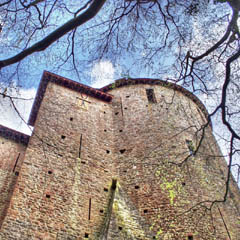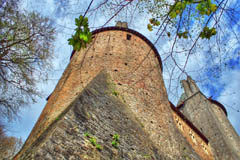A 19th century Gothic Revival castle built on the remains of a genuine 13th century fortification. A castle was probably founded on the site in the early thirteenth century by a Welsh chieftain named Ifor Bach. In the late thirteenth century the castle site was claimed by the De Clare family because of its strategic importance, commanding both the plains area and the entrance to the Taff valley. The castle was rebuilt in stone and consisted of a keep, towers, an enclosed courtyard and a gatehouse.
It is assumed, in the absence of documentary evidence, that the castle was almost completely destroyed in the Welsh rebellions of the early 14th Century. Certainly, in Tudor times, John Leyland described it as "al in ruine". It was in this wrecked and overgrown state in 1871, that John Crichton-Stuart, 3rd Marquess of Bute, ordered the site to be cleared of vegetation and debris and his architect, William Burges drew up plans for a full reconstruction. Burges and the Marquess had, by that time, been working for over three years on the rebuilding of Cardiff Castle and the aim at Castle Coch was to achieve another gothic revival masterpiece in the appropriate 13th century style.
A very full, and beautiful, set of drawings for the planned rebuilding exists, together with a full architectural justification by Burges of his plans. The most picturesque, and archaeologically questionable, features of the reconstruction are the three conical roofs to the towers. Burges undoubtedly, and rightly, desired the roofs for their visual effect, admitting that they were "utterly conjectural" but "more picturesque and (..) affording much more accommodation"; but was determined to defend them as historically sound. "It is true that some antiquaries deny the existence of high roofs in English Mediaeval Military Architecture, and ask objectors to point out examples. As nearly every Castle in the country has been ruined for more than two centuries...it is not surprising that no examples are to be found. But we may form a very fair idea of the case if we consult contemporary (manuscripts) and if we do we find nearly an equal number of towers with flat roofs as those with pointed roofs. The case appears to me to be thus: if a tower presented a good situation for military engines, it had a flat top; if the contrary, it had a high roof to guarantee the defenders from the rain and the lighter sorts of missiles. Thus an arrow could not pierce the roof, but if the latter were absent and the arrow was fired upright, in its downward flight it might occasion the same accident to the defenders as happened to Harold at Hastings."
The three towers, the Keep, the Well Tower and the Kitchen Tower, incorporate a sumptuous, but very limited, series of apartments; of which the main sequence, the Castellan's Rooms, lie within the Keep. The Hall, the Drawing Room, Lord Bute's Bedroom and Lady Bute's bedroom comprise, in total, perhaps the most exhilarating suite of rooms in the High Victorian Gothic style to be found anywhere in Britain, although the second and fourth hugely exceed in quality the Hall and the Lord's chamber. The weakness of some (much?) of the interior decoration can perhaps be attributed to Burges' early death. Although the castle was built by 1881, an enormous amount remained to be done internally and worked continued for a decade after his death. Regrettably, some of the decoration has a weak and anaemic quality that can also be seen in parts of Cardiff Castle, e.g. the Great Hall.
This aside, the Drawing Room and Lady Bute's bedroom are fantastical creations with an exuberance that overpowers the visitor. The ceilings and wall paintings are dazzling in their richness and fully equal the best achieved at Cardiff Castle. In addition, the exterior of the castle is an awesome display of architectural power and ability. In a lecture, Burges called on architectural students to "study the great broad masses, the strong unchamfered lines", and the combinations of cone, square and drum which Burges achieved at Castell Coch demonstrate his architectural mastery.
Following Burges' death, work on the interior continued for another ten years. But the Castle was not suitable for, nor was it intended to be, a permanent residence and the family's visits were infrequent although the Marchioness and her daughter, Lady Margaret Bute, did occupy it for a period following the death of the Marquess in 1900. In 1950, the 5th Marquess of Bute placed the Castle in the care of the Ministry of Works. It is now administered by Cadw on behalf of the National Assembly for Wales. |

